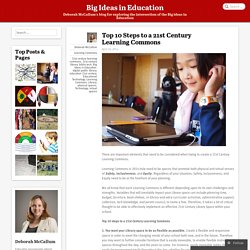

Planning. Chattanooga in the right place. Question Brainstorm. Making Matters! How the Maker Movement Is Transforming Education. By Sylvia Libow Martinez and Gary S.

Stager The Maker Movement, a technological and creative learning revolution underway around the globe, has exciting and vast implications for the world of education. New tools and technology, such as 3D printing, robotics, microprocessors, wearable computing, e-textiles, “smart” materials, and programming languages are being invented at an unprecedented pace. The Maker Movement creates affordable or even free versions of these inventions, while sharing tools and ideas online to create a vibrant, collaborative community of global problem-solvers. Fortunately for teachers, the Maker Movement overlaps with the natural inclinations of children and the power of learning by doing.
One might try to marginalize robotics or 3D fabrication as having nothing to do with “real” science and dismiss such activities as play or as just super-charged hobbies. Three big game-changers of the Maker Movement should be on every school’s radar: Celebrating Young Talent. Go to Background Page. Maker-movement. What do you do in a Maker Space?

What is the Maker Movement? Have you ever dreamed of making your invention ideas a reality? Perhaps you believe that you aren’t creative? The primary promoter of the Maker Movement is Dale Dougherty; when he launched Make Magazine in 2005 he sparked a worldwide Maker Movement. It is a place for everyone, creative and not creative, to come and explore their passions using raw materials, tools, technology, repurposed items and imagination. Who is found in a Students, boys and girls, are drawn in to the Maker Space experience. The purpose of the adults in the Maker Space is to provide open access to knowledgeable people who may help students discover ways to solve design challenges. The simple answer is you make things. Where are Maker Spaces located? A Maker Space should be easily accessed by its patrons; in a school, the library is ideal. Learning is disguised as exploration and play. What are the expectations of the students in a What is the Maker Movement? Library Makerspace Ideas on Pinterest.
The “Why” Behind A School’s Learning Commons. Warning: Division by zero in /home/learn718/public_html/blog/wp-content/plugins/knowledgering-post-popularity-graph-tool/knowledgeringppgt.php on line 207 Last week I was fortunate to have the opportunity to create a pecha kucha and speak at the Changing Times: Inspiring Libraries Summit.

Drawing upon the work that was done at John Oliver Secondary School in transforming the school library into a Learning Commons, I spent some time reflecting on the why behind this change. My thoughts and mental meanderings lead to the following presentation: Embracing change – it means daring to be different and accepting that people may strike at your idea like it’s a piñata.
I want to talk to you today about the benefits of transforming a school library to a Learning Commons and how this change can provide the “street lamps” that help guide us along in our 21st century learning journey. Change, moving from the known to the unknown, can be an unsettling proposition. How do we Courtesy of Ok great. Why? Student friendly Library DesignTXLA 2014. Flexible Physical Space. Learning Commons Video. Simply reading titles is fine. There are important elements that need to be considered when trying to create a 21st Century Learning Commons.

Learning Commons in 2014 truly need to be spaces that promote both physical and virtual senses of Safety, Inclusiveness, and Equity. Regardless of your situation, Safety, Inclusiveness, and Equity need to be at the forefront of your planning. We all know that each Learning Commons is different depending upon its its own challenges and strengths. Variables that will inevitably impact your Library space can include:planning time, budget, furniture, book shelves, in-library and extra-curricular activities, administrative support, collection, tech knowledge, and parent council, to name a few. Therefore, it takes a lot of critical thought to be able to effectively implement an effective 21st Century Library Space within your school. Top 10 steps to a 21st Century Learning Commons 1. 2. 3. 4. 5. 6. 7. 8. 9. 10. This list is by no means exhaustive! Deborah McCallum Like this: Related. Slides share background for space needs based on changes in education.